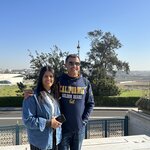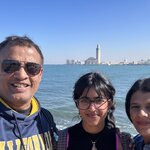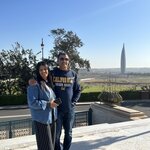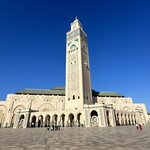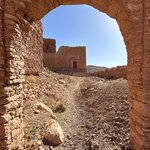This adventure-packed trip showcases Morocco's highlights, including Marrakech, Casablanca, Fes, and the desert. Start in Marrakech for colorful markets and architecture, then head inland to explore kasbahs and sleep under the stars in a desert camp amid the Sahara dunes. Visit Fes' narrow streets and the medieval medina before ending the trip in Casablanca to see the Hassan II Mosque and the world's tallest minaret.
Highlights
- Visit an argan tree cooperative and learn about the oil extraction process
- Experience the vibrant culture of the Sahara desert communities
- Explore hidden oases, old caravan routes, and fortified kasbahs in the desert
- See souks and markets and take a cooking class in Marrakech
Brief Itinerary
| Day | Highlights | Overnight |
|---|---|---|
| Day 1 | Arrival in Marrakech & Private City Tour | Marrakech |
| Day 2 | Marrakech to Boumalne Dades via Ouarzazate | Boumalne Dades |
| Day 3 | Boumalne Dades to Merzouga Sunset Camel Ride via Tinghir & Rissani | Merzouga |
| Day 4 | Merzouga to Fes via Rissani, Midelt & the Atlas Mountains | Fes |
| Day 5 | Fes to Casablanca via Rabat, Self-Guided Tour | Casablanca |
| Day 6 | Depart Casablanca |
Detailed Itinerary
Day 1: Arrive in Marrakech & Private City Tour

Next, your guide will take you to the Koutoubia Mosque and Gardens, the city's largest mosque. Although non-Muslims can't enter, you can still admire the grounds and exterior, including its remarkable minaret. Pass through one of the Medina's (old town's) historical gates and meander its twisting alleyways to the souks (markets) and hidden Fondouks (historic caravanserai once used as hotels for travelers and merchants).
Start at Jemaa el-Fna Square, the city's landmark plaza filled with markets, street food, and performers. From here, you'll stroll to a few of the best souks, with your guide leading the way. You'll find the famed spice towers at Souk el Attarin and traditional Moroccan slippers at Souk Smata. But don't miss Souk des Teinturiers, where you can watch locals dyeing and hanging cloth and yarn. Although it can be fun to barter, your guide is happy to help you make a purchase.
In the evening, follow your nose to the wonderful smells that waft from food stalls back in Jemaa el-Fna Square. Watch locals prepare authentic delicacies and taste the flavors of Marrakech as the sun goes down and the street performers come out to entertain. If you prefer a quieter eating experience, choose from one of the many cafes sitting above the square and simply watch the action below.
Day 2: Marrakech to Boumalne Dades via Ouarzazate

As you leave the busy city behind, you'll transition from flat surroundings to verdant hills. You'll begin winding over the pass where sweeping vistas emerge. Try to spot the range's highest summit of Mount Toubkal, which sits at 13,671 feet (4,167 m). You'll also pass traditional Berber villages and catch glimpses of their unique farmland. The authentic mud-brick homes are quite the unique contrast to the stark modern buildings of today.
Make a stop in the town of Taddert and visit the Argan Oil Cooperative. Learn how local women extract precious oil from the Argan nut for use in the health, food, and cosmetic industries. The oil production is an excellent example of rural economic development in Morocco.
Next, take a break in the picturesque town of Ouarzazate, which gained popularity thanks to the film industry. You have an option to tour a movie studio or visit the Musée du Cinema to learn about the films produced in the region and get up close with props and sets. An isolated military outpost during the years of the French protectorate, Ouarzazate—which means "no noise" in the Berber Tamazight language—long lived up to its name. Today, however, the town is Morocco's Hollywood, and you can regularly see moviemakers setting up shop in this sprawling desert crossroads with wide, palm-fringed boulevards. The center of Ouarzazate is easily explored on foot. Avenue Mohammed V, the main street, runs from east to west with shops, cafés, banks, pharmacies, and tour agencies all along its length.
On the way out of the town, enjoy a quick visit to the el Mansour Reservoir, an important water source for the local farming community. At this point, your journey starts to follow the Valley of a Thousand Kasbahs, with many kasbahs (defense fortresses) in disrepair—they were constructed with "rammed earth," a building technique using raw materials. You'll pass many small towns where you can see traditional farming methods in use. Be on the lookout for nomads tending to their animals, especially as you near Boumalne Dades.
Enjoy the scenery as you enter the Dades Valley and continue to Kela'a M'gouna, the "Valley of the Roses." Here, you can admire the cultivated rose bushes and visit a rose collective. Learn how artisans convert rose petals into rose water and oil for the cosmetic industry.
Your final stop is Boumalne Dades, a major town straddling the Dades River. Enjoy the scenes of arid landscapes and traditional architecture contrasting with the verdant river valley.
Plan your trip to Morocco
Chat with a local specialist who can help organize your trip.
Chat with a local specialist who can help organize your trip.
Day 3: Boumalne Dades to Merzouga Sunset Camel Ride via Tinerhir & Rissani

Your first stop is the desert town of Tinghir. Here you'll find fantastic views of neighboring villages along an extensive river oasis that features 30 miles (48 km) of palm trees. The surrounding desert landscape reveals impressive buttes, mesas, and plateaus. With its ancient and colorful Jewish quarter, Tinghir also offers a glimpse into ancestral Moroccan Jewry. You can visit Elhaj Ait Ali, the old Jewish quarter, and admire its interesting architecture.
Continue to the Todra Gorge at 984 feet (300 meters) high, featuring stunning red-stained limestones. Here you can enjoy an easy walk through the gorge or relax in the cool shallow water. Just before reaching Erfoud, you'll start to get glimpses of the ever-shifting Saharan dunes.
Erfoud is a bustling market town known for its annual Date Festival, fossil mining, and artisan factories. While en route, enjoy views of the hillside mines before visiting a local artisan collective to learn about the area's fossils. Watch the full process of how the fossil-rich rock transforms into beautiful objects, like tables, plates, and bowls.
Next, you'll make your way to the town of Rissani, entering through its impressive gate. Known for its livestock auction, spend some time observing the donkey "parking lot" and walking around the town's popular market. Maison Tuareg is a storehouse filled with traditional arts and crafts, including carpets, jewelry, leather goods, and more.
As you continue, you'll soon see the ever-changing sand waves of Erg Chebbi in the distance. Erg Chebbi is an extensive set of dunes covering almost 14 square miles (35 sq km), with some peaks rising over 650 feet (200 m). The color and shape change depending on the time of day and the wind, which is especially enriching just before sunset. Although not as vast, these dunes are much taller than those found in Zagora.
Upon arrival near Merzouga, enjoy a short break as you prepare for a camel ride through the dunes, reaching your luxury camp just before sunset. After settling into your tent, climb up the nearest dune to watch the sunset display its color show across the sands. Head back to camp for dinner and a night by the campfire, enjoying traditional Berber music from the locals. Before climbing into bed, savor the stars strewn across the unhindered night sky.
Although we recommend the atmosphere of the desert tents, everyone has their own preferences. If modern comfort is more your style, you can always opt for a comfortable hotel or auberge in Merzouga. In the morning, transform into an early riser (if you're not one already) for an exceptional Saharan sunrise!
Day 4: Merzouga to Fes via Rissani, Midelt, & the Atlas Mountains

Your first stop is the town of Rissani, entering through its impressive gate. Known for its livestock auction, spend some time observing the donkey "parking lot" and walking around the town's popular market. Maison Tuareg is a storehouse filled with traditional arts and crafts, including carpets, jewelry, leather goods, and more.
Next, visit Erfoud, a bustling market town known for its annual Date Festival, fossil mining, and artisan factories. While en route, enjoy views of the hillside mines before visiting a local artisan collective to learn about the area's fossils. Watch the full process of how the fossil-rich rock transforms into beautiful objects.
Continue over the Tizi n'Talrhemt Pass and into the Ziz Valley, famous for its hidden oases and palm tree clusters. Along the road, you'll see many fortified houses known as ksars. Merchants built these homes to protect precious products and items such as gold, salt, and spices. Stop for lunch in Midelt, known as the "Apple City," thanks to the nearby Moulouya River and its surrounding fruit orchards.
Next, you'll climb an elevation of 7,146 feet (2,178 m) over the Col du Zad Pass. Enjoy the scenery as you twist through the cedar forests of the Atlas Mountains. Keep your eyes peeled for the local Barbary macaque monkeys that socialize in the trees!
You'll arrive in Fes late in the afternoon. After settling into your accommodation, head out to explore the city. Start at the Marinid Tombs, where you can enjoy a lovely panorama of the old city. On the hillside below, you may see leather drying in the sun. Then make your way into the bustling Medina and enjoy navigating Fes' charming streets.
Day 5: Fes to Casablanca via Rabat & Self-Guided Tour

Enjoy a comfortable private transfer from Fes to your accommodation in Casablanca, which takes about four hours. Along the way, your driver will stop at the imperial city of Rabat, Morocco's capital since 1956. As this is a private transfer, you're welcome to spend your morning exploring Fes one last time before heading out.
Rabat is the second-largest city in the country and earned the UNESCO World Heritage designation in 2012. Upon arrival, explore the medieval fortification of the Chellah Necropolis, where you can wander the Roman and Islamic ruins. Stroll through the Medina (old town) to find the Hassan Tower and Mausoleum of Mohamed V. This abandoned 12th-century project features the minaret of an incomplete mosque and some 200 columns.
Spend time exploring historic Medina and roam through the charming streets. Stop at the souks (markets) to peruse local crafts and goods, such as rugs, spices, slippers, jewelry, leather, and more. Although bartering is part of the fun, your guide is happy to help you make a purchase.
You can also visit the 20th-century Andalusian Gardens and enjoy the serene space away from the crowds. Then pass through the grand door of the Kasbah des Oudaïas, the gate out of Rabat's old city center. The Kasbah des Oudaïas is home to the city’s oldest mosque and Musée des Oudaïas handicrafts museum.
When ready, you'll continue your drive to Casablanca. After settling in, head out to see the massive Hassan II Mosque (home to the tallest minaret in the world) glowing in the dusky light. Then explore the Hobous, Casablanca’s “New Medina.” Established in the 1930s by the French, the charming streets feature art deco architecture. Pop into some artisan shops to browse local crafts, including olives, textiles, and spices. Or venture into the Old Medina. At the beginning of the 20th century, Casablanca consisted only of the old medina, which comprised no more than a few thousand inhabitants. The walls around the old town were originally pierced by four gates, two of which survive today. Bab Marrakech and Bab el-Jedid, on the western side, face onto Boulevard Tahar el-Alaoui.
You can also relax in Mohamed V. Square, an airy plaza with tall palm trees and French Colonial architecture. Stroll around the gardens, enjoy the fountain, or relax on a bench to people-watch. If you'd like to take a longer walk, you'll find Arab League Park nearby, home to 30 acres of walking paths and green spaces. Bordering the park on its northwest side is the Sacred Heart Cathedral.
Check out the Clock Tower, which marks the busiest entrance to the old medina and is one of the most recognizable landmarks in downtown Casablanca. The current tower is a 1993 reproduction of the original 1911 structure, which fell into disrepair and was dismantled around 1950. Or explore the Notre Dame Church. A striking example of European modernism, this 1956 Catholic church is notable for its elongated concrete entrance and striking stained-glass windows, which French artist Gabriel Loire designed. It overlooks the Rond-point de l'Europe (aka Mers Sultan Roundabout).
Self-Guided Tour
If you have extra time to spare in Casablanca, you can explore some of its not-so-touristy sites. Although the Medina (old town) isn't necessarily a must-see (Casablanca's is only around 200 years old, relatively new than Fes and Marrakech's), you can still enjoy a quick stroll through the markets. But if you’re visiting those other cities, you don't need to spend much time in Casablanca's Medina. Instead, explore some of the city's unique history and off-the-beaten-path sites!
Casablanca is the country’s most modern city and a conglomeration of stark-white buildings. The present city, known colloquially as “Casa” or “El Beida,” was founded in 1912. Straddling east and west, it's the commercial and financial capital of Morocco where tradition and modernity co-exist.
In the 7th century, Casablanca was no more than a small Berber settlement clinging to the slopes of the Anfa Hills. However, for strategic and commercial reasons, it was already attracting the attention of foreign powers. In 1468, the town was won by the Portuguese, who destroyed the city’s private ships. In the early 15th century, the port became a haven for pirates and racketeers. Anfa pirates became such a serious threat later in the century that the Portuguese sent 50 ships and 10,000 men to subdue them, leaving Anfa in a state of ruins.
By the mid-1800s, Europe was booming and turned to Morocco for increased supplies of grain and wool. The fertile plains around Casablanca were soon supplying European markets, and agents and traders flocked back to the city. Spanish merchants renamed the city Casablanca, and by the beginning of the 20th century, the French had secured permission to build an artificial harbor.
The city's handsome Moresque buildings, which meld French-colonial design and traditional Moroccan style, are best admired in the downtown area. Visitors who spend time there in the Quartier Habous and the beachside suburb of Ain Diab will enjoy a blend of local flavors, historic charms, and modern amenities. This old pirate lair continuously looks toward the future, embracing the European-urban sophistication underpinning life here for the past century.
Other recommendations include:
- Explore the Hobous, Casablanca’s “New Medina.” Established in the 1930s by the French, Casablanca's new Medina is quite different than its old town. Here, you can walk around the charming streets and admire art deco architecture. Pop into some artisan shops to browse local crafts, including olives, textiles, and spices. As an idealized version of a traditional medina, you'll appreciate the clean streets, attractive Mauresque buildings and arcades, neat rows of shop stalls, and even a small park.
Upon its establishment, the new medina was a unique experiment: a medina built to Western standards to accommodate the first rural exodus in the 1920s. Though undeniably ersatz, it blends Moroccan architecture with French ideals, and its souq offers excellent opportunities to source souvenirs. The Royal Palace (closed to the public) is to the north of the district. To the south, you'll find the old Mahakma du Pasha with its more than 60 rooms decorated with sculpted wooden ceilings, stuccowork, wrought-iron railings, and earthenware floors.
- Visit the Old Medina. At the beginning of the 20th century, Casablanca consisted only of the old medina, which comprised no more than a few thousand inhabitants. The walls around the old town were originally pierced by four gates, two of which survive today. Bab Marrakech and Bab el-Jedid, on the western side, face onto Boulevard Tahar el-Alaoui. A daily market, with jewelers, barbers, public letter-writers, and so on, stretches out along the length of the walls. Opposite the fishing harbor is the scala, a fortified bastion built in the 18th century during the reign of Sidi Mohammed ben Abdallah. Behind the bastion is the marabout (shrine) with a double crown of merlons, containing the Tomb of Sidi Allal el-Kairouani.
- Stroll the Beach Promenade. Casablanca is set on the Atlantic Ocean and offers a scenic promenade, perfect for a leisurely walk. Follow the Boulevard de la Corniche between two of the city's beaches. Often called Morocco’s “Miami,” you'll find several buzzy cafes, restaurants, and bars along this stretch. You can also visit the El Hank Lighthouse and enjoy views of the Hassan II Mosque.
- Visit Rick's Cafe. If your main reason to tour Casablanca is to follow Ingrid Bergman and Humphrey Bogart's footsteps, consider a visit to Rick’s Café, which recreates the famous scene in the legendary film!
- Check out the Clock Tower: Marking the busiest entrance to the old medina, this clock tower is one of the most recognizable landmarks in downtown Casablanca. The current tower is a 1993 reproduction of the original 1911 structure, which fell into disrepair and was dismantled around 1950.
- Explore the Notre Dame Church: A striking example of European modernism, this 1956 Catholic church is notable for its elongated concrete entrance and striking stained-glass windows, which French artist Gabriel Loire designed. It overlooks the Rond-point de l'Europe (aka Mers Sultan Roundabout).
Day 6: Depart Casablanca


